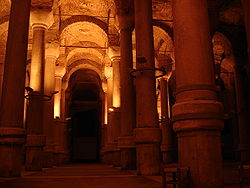- Cistern of Philoxenos
-
The Cistern of Philoxenos (Greek: Κινστέρνα Φιλοξένου), or Binbirdirek Cistern, is a man-made subterranean reservoir in Istanbul, situated between the Forum of Constantine and the Hippodrome of Constantinople in the Sultanahmet district. It has been restored and is now visited as a tourist attraction.
Contents
Construction
The cistern was constructed under a palace, often identified as the Palace of Antiochos in the 5th century. The reservoir has a surface area of 3640 m2, storing 40,000 m3 of water. The cistern is composed of a large hypostyle chamber supported by vaults. The 224 columns, each 14 to 15 meters tall, are made of marble from nearby Marmara Island. Each column is a superposition of two columns, joined by a marble ring. The floor of the cistern was later reinforced, so that only the upper column and a short sleeve of the lower column are thus visible. A part of the original exterior is now preserved on display near the entrance. Most of the columns, and also the caps, are engraved with a Greek mason's mark.
Restoration
The cistern was restored by Justinian I in the 6th century, after the palace was completely destroyed in a fire in 475. After the conquest of the city by the Ottomans in 1453, the cistern fell into disuse, and was forgotten until rediscovered during the construction of Fazli Pasha's palace on the same site in the 17th century.
1001 columns
The name Binbirdirek translates from Turkish as "1001 Columns" although the true number is only 224.
Sources
- Alexander Kazhdan (éd.), The Oxford Dictionary of Byzantium, 3 vols., Oxford University Press, 1991 (ISBN 0195046528), s. v. Constantinople, Monuments of : Cisterns, vol. 1, 518-519 ;
- (German) Wolfgang Müller-Wiener, Bildlexikon Zur Topographie Istanbuls: Byzantion, Konstantinupolis, Istanbul Bis Zum Beginn D. 17 Jh, Wasmuth, Tübingen, 1977 (ISBN 3-8030-1022-5), 280-281.
See also
- List of Roman cisterns
- Basilica Cistern (Istanbul)
- Theodosius Cistern (Istanbul)
Categories:- Roman cisterns
- Cisterns in Istanbul
- Reservoirs in Turkey
Wikimedia Foundation. 2010.

